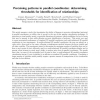Free Online Productivity Tools
i2Speak
i2Symbol
i2OCR
iTex2Img
iWeb2Print
iWeb2Shot
i2Type
iPdf2Split
iPdf2Merge
i2Bopomofo
i2Arabic
i2Style
i2Image
i2PDF
iLatex2Rtf
Sci2ools
IVS
2008
2008
Perceiving patterns in parallel coordinates: determining thresholds for identification of relationships
This article presents a study that investigates the ability of humans to perceive relationships (patterns) in parallel coordinates, an ability that is crucial to the use of this popular visualization technique. It introduces a visual quality metric, acceptable distortions of patterns, which establishes the level of noise that may be present in data while allowing accurate identification of patterns. This metric was used to assess perceptual performance of standard 2D parallel coordinates and multi-relational 3D parallel coordinates in two experiments. In multi-relational 3D parallel coordinates the axes are placed on a circle with a focus axis in the centre, allowing a simultaneous analysis between the focus variable and all other variables. The experiments aimed to determine the maximum number of variables that can be, from a user's point of view, efficiently used in a multi-relational 3D parallel coordinates display and to present a first attempt to study users' ability to...
| Added | 12 Dec 2010 |
| Updated | 12 Dec 2010 |
| Type | Journal |
| Year | 2008 |
| Where | IVS |
| Authors | Jimmy Johansson, Camilla Forsell, Mats Lind, Matthew Cooper |
Comments (0)

